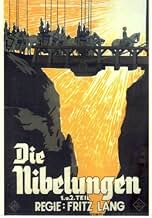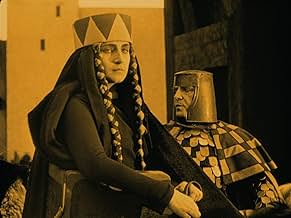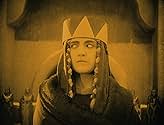IMDb-BEWERTUNG
7,9/10
5305
IHRE BEWERTUNG
Füge eine Handlung in deiner Sprache hinzuPrincess Kriemhild vows to avenge her husband's murder but must overcome her brothers who swore allegiance to Hagen. She marries Etzel, King of the Huns, and persuades his army to attack Hag... Alles lesenPrincess Kriemhild vows to avenge her husband's murder but must overcome her brothers who swore allegiance to Hagen. She marries Etzel, King of the Huns, and persuades his army to attack Hagen, but she loses more than she bargained for.Princess Kriemhild vows to avenge her husband's murder but must overcome her brothers who swore allegiance to Hagen. She marries Etzel, King of the Huns, and persuades his army to attack Hagen, but she loses more than she bargained for.
- Auszeichnungen
- 1 Nominierung insgesamt
Yuri Yurovsky
- The Priest
- (as Georg Jurowski)
Empfohlene Bewertungen
Please see also my comment on Die Nibelungen part 1: Siegfried.
The second part of UFA studio's gargantuan production of the Nibelungen saga continues in the stylised, symphonic and emotionally detached manner of its predecessor. However, whereas part one was a passionless portrayal of individual acts of heroism, part two is a chaotic depiction of bloodletting on a grand scale.
As in part one, director Fritz Lang maintains a continuous dynamic rhythm, with the pace of the action and the complexity of the shot composition rising and falling smoothly as the tone of each scene demands. These pictures should only be watched with the note-perfect Gottfried Huppertz score, which fortunately is on the Kino DVD. Now, with this focus on mass action, Lang is presented with greater challenges in staging. The action sequences in his earliest features were often badly constructed, but now he simply makes them part of that rhythmic flow, with the level of activity on the screen swelling up like an orchestra.
But just as part one made us witness Siegfried's adventures matter-of-factly and without excitement, part two presents warfare as devastating tragedy. In both pictures, there is a deliberate lack of emotional connection with the characters. That's why Lang mostly keeps the camera outside of the action, never allowing us to feel as if we are there (and this is significant because involving the audience is normally a distinction of Lang's work). That's also why the performances are unnaturally theatrical, with the actors lurching around like constipated sleepwalkers.
Nevertheless, Kriemhild's revenge does constantly deal with emotions, and is in fact profoundly humanist. The one moment of naturalism is when Atilla holds his baby son for the first time, and Lang actually emphasises the tenderness of this scene by building up to it with the wild, frantic ride of the huns. The point is that Lang never manipulates us into taking sides, and in that respect this version has more in common with the original saga than the Wagner opera. The climactic slaughter is the very antithesis of a rousing battle scene. Why then did Hitler and co. get so teary-eyed over it, a fact which has unfairly tarnished the reputation of these films? Because the unwavering racial ideology of the Nazis made them automatically view the Nibelungs as the good guys, even if they do kill babies and betray their own kin. For Hitler, their downfall would always be a nationalist tragedy, not a human one.
But for us non-nazi viewers, what makes this picture enjoyable is its beautiful sense of pageantry and musical rhythm. When you see these fully-developed silent pictures of Lang's, it makes you realise how much he was wasted in Hollywood. Rather than saddling him with low-budget potboilers, they should have put him to work on a few of those sword-and-sandal epics, pictures that do not have to be believable and do not have to move us emotionally, where it's the poetic, operatic tonality that sweeps us along.
The second part of UFA studio's gargantuan production of the Nibelungen saga continues in the stylised, symphonic and emotionally detached manner of its predecessor. However, whereas part one was a passionless portrayal of individual acts of heroism, part two is a chaotic depiction of bloodletting on a grand scale.
As in part one, director Fritz Lang maintains a continuous dynamic rhythm, with the pace of the action and the complexity of the shot composition rising and falling smoothly as the tone of each scene demands. These pictures should only be watched with the note-perfect Gottfried Huppertz score, which fortunately is on the Kino DVD. Now, with this focus on mass action, Lang is presented with greater challenges in staging. The action sequences in his earliest features were often badly constructed, but now he simply makes them part of that rhythmic flow, with the level of activity on the screen swelling up like an orchestra.
But just as part one made us witness Siegfried's adventures matter-of-factly and without excitement, part two presents warfare as devastating tragedy. In both pictures, there is a deliberate lack of emotional connection with the characters. That's why Lang mostly keeps the camera outside of the action, never allowing us to feel as if we are there (and this is significant because involving the audience is normally a distinction of Lang's work). That's also why the performances are unnaturally theatrical, with the actors lurching around like constipated sleepwalkers.
Nevertheless, Kriemhild's revenge does constantly deal with emotions, and is in fact profoundly humanist. The one moment of naturalism is when Atilla holds his baby son for the first time, and Lang actually emphasises the tenderness of this scene by building up to it with the wild, frantic ride of the huns. The point is that Lang never manipulates us into taking sides, and in that respect this version has more in common with the original saga than the Wagner opera. The climactic slaughter is the very antithesis of a rousing battle scene. Why then did Hitler and co. get so teary-eyed over it, a fact which has unfairly tarnished the reputation of these films? Because the unwavering racial ideology of the Nazis made them automatically view the Nibelungs as the good guys, even if they do kill babies and betray their own kin. For Hitler, their downfall would always be a nationalist tragedy, not a human one.
But for us non-nazi viewers, what makes this picture enjoyable is its beautiful sense of pageantry and musical rhythm. When you see these fully-developed silent pictures of Lang's, it makes you realise how much he was wasted in Hollywood. Rather than saddling him with low-budget potboilers, they should have put him to work on a few of those sword-and-sandal epics, pictures that do not have to be believable and do not have to move us emotionally, where it's the poetic, operatic tonality that sweeps us along.
Die Nibelungen: Kriemhild's Revenge (1924)
** (out of 4)
Second part of Fritz Lang's Die Nibelungen is a major step down from the previous part. In this segment (as the title says), Kriemhild seeks revenge for the death of her husband. This part of the film runs 146-minutes, which brings the total running time just under five hours and I've gotta wonder why on Earth it would take this long to tell a story. The first part was actually fairly interesting due to a good leading character as well as several memorable scenes including the infamous fight with a dragon and the bathing in its blood. This part just goes on and on and on without any real excitement until the very end of the movie. Another major problem is that the actress (Margarete Schoen) is downright boring and hard to watch. The amazing set design and costumes are on full display again, which makes it worth watching the entire film for.
** (out of 4)
Second part of Fritz Lang's Die Nibelungen is a major step down from the previous part. In this segment (as the title says), Kriemhild seeks revenge for the death of her husband. This part of the film runs 146-minutes, which brings the total running time just under five hours and I've gotta wonder why on Earth it would take this long to tell a story. The first part was actually fairly interesting due to a good leading character as well as several memorable scenes including the infamous fight with a dragon and the bathing in its blood. This part just goes on and on and on without any real excitement until the very end of the movie. Another major problem is that the actress (Margarete Schoen) is downright boring and hard to watch. The amazing set design and costumes are on full display again, which makes it worth watching the entire film for.
This second half of Fritz Lang's epic filming of the Nibelungen Saga has many of the same strengths as the first, with memorable characters and interesting, atmospheric settings. This part of the story continues with many of the same characters, but the story itself is of a much different nature. There is less complexity but more action, with the entire focus being on Kriemhild and her inflexible desire for revenge. This part of the story does not have such interesting relationships amongst the characters as did the first part, but instead provides first and foremost an unforgettable portrait of the obsessed Kriemhild.
She, Gunther, and Hagen are now thoroughly defined characters who have chosen where they stand, and so there is not the kind of dramatic uncertainty and tension that the first part held. Instead, there is a more straightforward battle of wills, but with an added wild card in the person of Attila, portrayed memorably and with great energy by Rudolf Klein-Rogge. Attila and the Huns are depicted in a way that most likely has little basis in history, but it is certainly interesting to see the bizarre fashion in which the Huns and their world are portrayed. As events unfold, the developments are not always fully plausible, but the stakes and the pressure on each side steadily rise, building to an intense climax.
What you remember most after the film is over is the remorseless, implacable Kriemhild. With her costume obscuring almost everything else, Margarete Schön portrays the depth of Kriemhild's emotions and determination using only her face and, especially, her eyes. It is about as memorable a portrait as you will find in cinema of the madness and destructive fury of revenge. While "Kriemhild's Revenge", as a whole, does not have the thematic depth of "Siegfried", it succeeds in establishing this central image in a manner not easily forgotten.
She, Gunther, and Hagen are now thoroughly defined characters who have chosen where they stand, and so there is not the kind of dramatic uncertainty and tension that the first part held. Instead, there is a more straightforward battle of wills, but with an added wild card in the person of Attila, portrayed memorably and with great energy by Rudolf Klein-Rogge. Attila and the Huns are depicted in a way that most likely has little basis in history, but it is certainly interesting to see the bizarre fashion in which the Huns and their world are portrayed. As events unfold, the developments are not always fully plausible, but the stakes and the pressure on each side steadily rise, building to an intense climax.
What you remember most after the film is over is the remorseless, implacable Kriemhild. With her costume obscuring almost everything else, Margarete Schön portrays the depth of Kriemhild's emotions and determination using only her face and, especially, her eyes. It is about as memorable a portrait as you will find in cinema of the madness and destructive fury of revenge. While "Kriemhild's Revenge", as a whole, does not have the thematic depth of "Siegfried", it succeeds in establishing this central image in a manner not easily forgotten.
Impressive sets, costumes, and action highlight this 2 hour conclusion. The surprisingly good restoration was available for both parts on Netflix.
In some ways I suspect intentional and not, the movie subtext lays out the cultural flaws of the German/Austrian people following World War 1. The Burgundian oath upheld despite treachery and infanticide to the point of self destruction. An overwhelming need for revenge with no compromise or limit to the cost of obtaining it.
I imagine Fritz Lang and his co-writer wife sought to emphasize these faults following the war, which leads to the mutual destruction of the entire lot of Burgundy characters. Curiously the result ennobles both sides.
The non Germanic characters are grubby, disfigured, inferior animals. Only the extremes of pride, honor and infighting seem to hold the Germanic kingdom back. Within this subtext, one might see omens for the world that would be realized less than 15 years later.
The resulting film shares the same fault of its characters. Excessive pride, honor and nationalism despite the destruction and failure it had wrought. It is a vast epic and well made. But more importantly, a view of the cultural undercurrents that undermined the treaties from the war to end all wars.
In some ways I suspect intentional and not, the movie subtext lays out the cultural flaws of the German/Austrian people following World War 1. The Burgundian oath upheld despite treachery and infanticide to the point of self destruction. An overwhelming need for revenge with no compromise or limit to the cost of obtaining it.
I imagine Fritz Lang and his co-writer wife sought to emphasize these faults following the war, which leads to the mutual destruction of the entire lot of Burgundy characters. Curiously the result ennobles both sides.
The non Germanic characters are grubby, disfigured, inferior animals. Only the extremes of pride, honor and infighting seem to hold the Germanic kingdom back. Within this subtext, one might see omens for the world that would be realized less than 15 years later.
The resulting film shares the same fault of its characters. Excessive pride, honor and nationalism despite the destruction and failure it had wrought. It is a vast epic and well made. But more importantly, a view of the cultural undercurrents that undermined the treaties from the war to end all wars.
I saw this film last night at a special movie theater showing in Nürnberg, and it was superb. I do have to admit that the original music composition of the cello player and percussion/xylophone player influenced the mood of the film, but the film itself also had force in its portrayal of the tragic Nibelungen saga.
If you are interested in silent films or in the Nibelungenlied, I highly recommend this film. The costumes were fantastic and creative, the sets were opulent and exotic, and the acting was dramatic and breathtaking (as is typical of silent film "tragedies") Unfortunately, I have not seen the first part of this film duo that concerns Siegfried. The story of this second film begins after Siegfried's death, when Kremhild (Gudrun in the Norse versions of the story) begins to plan her revenge against her brothers.
Also, I watched this film in German; I am a native English speaker and have a basic German knowledge. It was difficult to read the ?subtitles (what do you call that in silent films?) at first because of the old style German script, so I advise that if you watch it in German that you make sure you can differentiate your "k's", "f's", and "s's" in the old script. :)
If you are interested in silent films or in the Nibelungenlied, I highly recommend this film. The costumes were fantastic and creative, the sets were opulent and exotic, and the acting was dramatic and breathtaking (as is typical of silent film "tragedies") Unfortunately, I have not seen the first part of this film duo that concerns Siegfried. The story of this second film begins after Siegfried's death, when Kremhild (Gudrun in the Norse versions of the story) begins to plan her revenge against her brothers.
Also, I watched this film in German; I am a native English speaker and have a basic German knowledge. It was difficult to read the ?subtitles (what do you call that in silent films?) at first because of the old style German script, so I advise that if you watch it in German that you make sure you can differentiate your "k's", "f's", and "s's" in the old script. :)
Wusstest du schon
- WissenswertesAttila's castle was built life-size. The fire was started by Fritz Lang himself by shooting an arrow, tipped with burning magnesium, onto the roof.
- PatzerAt 19:38, as you see the treasure in the water, you can see a hand in the reflection to the left of the sword. Presumably it was filmed in a fish tank.
- Alternative VersionenA 2012 restoration project completed by the Friedrich-Wilhelm-Murnau-Stiftung has been released by Kino Lorber on both DVD and Blu-ray formats. Both "Die Nibelungen: Siegfried" (1924) and "Die Nibelungen: Kriemhild's Revenge" (1925) are included. The film's running times differ from other versions at 149 minutes and 131 minutes, respectively. This can be attributed to the fact that the restoration utilized some footage from different takes of scenes and slight adjustments were made to the 'frames-per-second' rate perhaps to present a more realistic flow of the action.
- VerbindungenEdited into Fritz Lang, le cercle du destin - Les films allemands (2004)
Top-Auswahl
Melde dich zum Bewerten an und greife auf die Watchlist für personalisierte Empfehlungen zu.
- How long is Die Nibelungen: Kriemhild's Revenge?Powered by Alexa
Details
- Erscheinungsdatum
- Herkunftsland
- Sprache
- Auch bekannt als
- Kriemhilds Rache - Der 2. Nibelungenfilm
- Drehorte
- Produktionsfirmen
- Weitere beteiligte Unternehmen bei IMDbPro anzeigen
- Laufzeit1 Stunde 37 Minuten
- Sound-Mix
- Seitenverhältnis
- 1.33 : 1
Zu dieser Seite beitragen
Bearbeitung vorschlagen oder fehlenden Inhalt hinzufügen

Oberste Lücke
By what name was Die Nibelungen: Kriemhilds Rache (1924) officially released in India in English?
Antwort





























